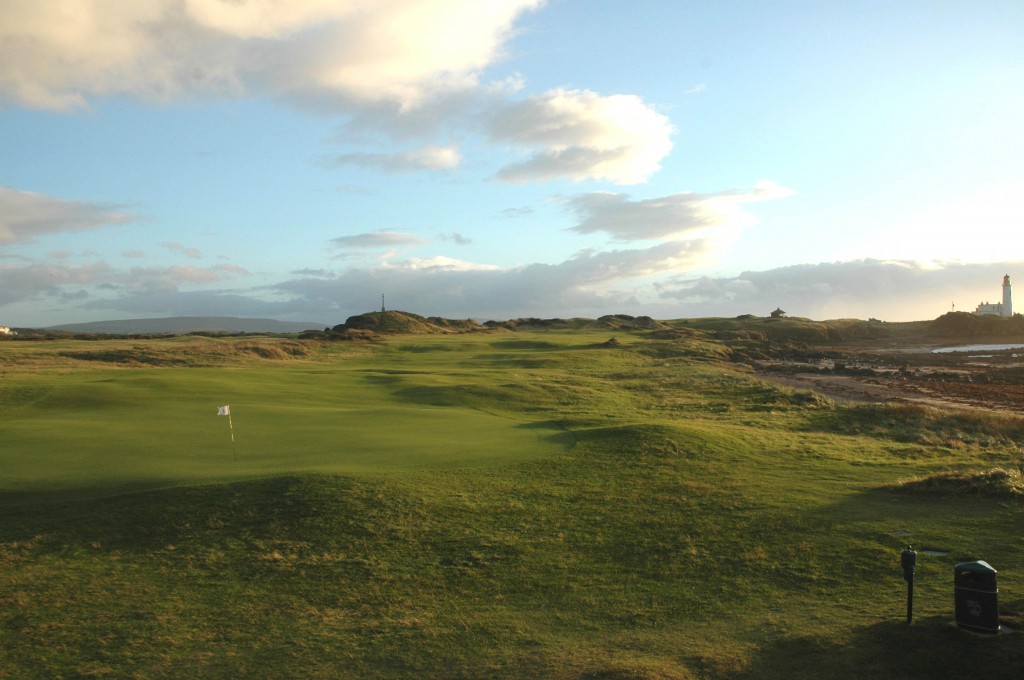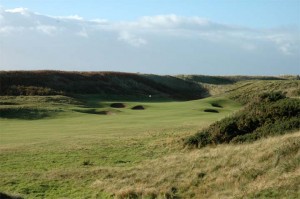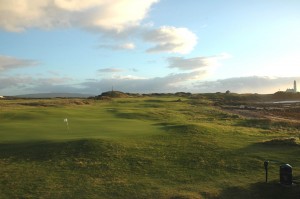If you haven’t played The Ailsa Course at Turnberry, you’ve wanted to. If you have played it, you’ve wanted to come back – as soon as you possibly could. If you’ve come back, and it happens to be cold, blowing a gale and raining, you play it anyway like a proper Golf Road Warrior.
The Ailsa is one of my favorite golf courses in the world. Everything about it is memorable – from the design of the course and its majestic setting to the variety of holes it offers and shots it demands. No golf course is perfect, but Turnberry comes as close as any I’ve experienced. And it doesn’t hurt that the Turnberry resort, with its grand hotel sitting high on a bluff overlooking the course, is a hedonist’s dream. So when the Golf Road Warriors group and I arrived here today, unsure if we would even be able to play, it was with disappointment. But play, we did. And even in a cold rain being blown sideways so hard that each drop hitting your skin like an icicle, it was still glorious.
I’ve played The Ailsa perhaps a dozen times – once in a 2-day Ryder Cup-style competition. It just never disappoints. And it’s gotten better over the years, with new bunkers added and other course enhancements undertaken before the 2009 Open Championship (under the direction of legendary course superintendent George Brown and his staff). The anticipation one feels before taking on this course is palpable. You know you’re in for a treat, but also a battle. The Ailsa will expose every weakness in your game, particularly if the weather happens to be acting Scottish. But O the joy when you play a hole well and manage a birdie – or par one of the tougher holes.
Named after the third Marquess of Ailsa, who owned the land on which the course was built, this par-70, 7,211-yard championship layout is one of golf’s most storied places. Home to four Open Championships, The Ailsa has shaped some of the most remarkable moments in the tournament’s history. It was here that Tom Watson won the famous “Duel in the Sun” against Jack Nicklaus in 1977. And it was here that Watson narrowly missed earning his 6th claret jug in 2009 when he was bested by Stewart Cink in a heart-breaking (for Watson and his many fans) playoff. In between, Greg Norman (1986) and Nick Price (1994) also won Open titles on the mighty Ailsa.
The course’s first three holes pose a fairly tough opening, particularly when the wind blows from the direction of its namesake, the brooding isle of Ailsa Craig, eleven miles out to sea. From the 4th to the 11th, the coastal scenery is magnificent and the course is demanding. Commanding a passage of stout hitting throughout, the 5th to the 8th holes are framed by sandy hillocks, while the 9th, 10th and 11th are flanked by craggy rocks.
The 5th hole here has always been one of my favorite tests in all of golf. You play your tee shot from a high promontory down into a secluded valley. The ideal line is to the right-hand side of the fairway, because your second shot must avoid a greenside bunker on the left on its way to the elevated green, nestled up in the embrace of the dunes.
On its stony ridge on the edge of the sea, the 9th hole is Turnberry’s trademark. The landmark lighthouse casts shadows over the 13th-Century ruins of Bruce’s Castle, the reputed birthplace of Scotland’s hero king, Robert the Bruce. The narrow path to the tee and the drive across the corner of the bay fills players with trepidation.
The 10th is another great hole, playing downhill along the water’s edge. And who doesn’t love the 16th, the par 4 with the elevated green fronted by a burn. How many poor souls have watched their approach shots arc toward the flag only to see them come up just a few inches shy and roll back down the shaved hill into that blasted burn?
The 17th, named Lang Whang, is the only par 5 on the course. A relatively short but challenging hole, its subtle contours slightly obstruct each shot – characteristic of the trickery of Turnberry. On the 18th, with the red-roofed hotel in sight to distract, gorse running down the right side and small dunes peeking up just enough to block your view of the landing zone, finding the fairway is even more difficult.
On this day, our Golf Road Warriors group woke up in Machrihanish, and set out for Ayrshire. We were supposed to have traveled across the sea aboard the fast RIB Kintyre Express, but it just wasn’t possible in this kind of weather. So we came by coach instead, thanks to the good people at Machrihanish Dunes, who brought us halfway, and our saviors on the Ayrshire side of things at PerryGolf.

PerryGolf's VIP coaches offer everything a traveling golfer could want - including a driver who really knows his business.
Angus McIntosh, our PerryGolf driver, ushered us to Turnberry in grand style aboard one of their luxurious VIP coaches. These coaches, replete with leather seats, work tables, a fridge full of beverages, are one of the very best ways to get around Scotland, particularly because of the expertise of the drivers PerryGolf uses. Angus, a jovial man whom we could immediately tell was someone we could count on, got us to Turnberry right on time for our lunch in the Tappie Toorie restaurant with Ricky Hall, Head Golf Professional. Hall told us all about the TaylorMade Performance Institute’s programs and explained what kind of things they teach at the Colin Montgomerie Links Golf Academy. This state-of-the-art facility is a great place to learn how to play links golf and is equipped with indoor hitting bays for providing instruction in all weather conditions. Hall said he never tires of coming to work in this magnificent place.
After lunch, it was off to the first tee, and once again, I was very happy that I had my waterproof Sun Mountain H2NO stand bag and Torrent rain gear. How windy was it? It was so windy that one of my fellow warriors laid down a shirt outside the coach only to have it blow out of reach – and eventually out of sight – before he stop it. This was a true 4-club wind, 5-club at times. Drives could be hit 400 yards, even on the rain-spattered turf. A distance of 170 yards could covered with a edge downwind and would require a full-blooded driver into the wind. Needless to say, par was a good score on any hole in these conditions. I was happy to end the round with four of them, but still could not break even bogey. Not that it mattered. Playing in those conditions was madness itself. But that’s the kind of thing a course like Turnberry will do to you. It’s a course you just can’t not play.




